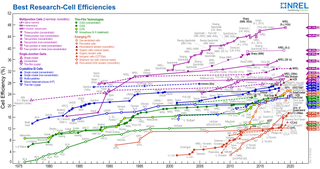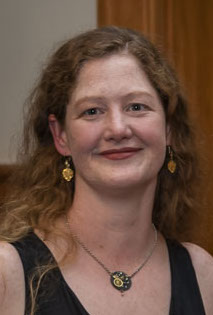Related Research Articles
The MacDiarmid Institute for Advanced Materials and Nanotechnology is a New Zealand Centre of Research Excellence (CoRE) specialising in materials science and nanotechnology. It is hosted by Victoria University of Wellington, and is a collaboration between five universities and two Crown Research Institutes.

Alan Graham MacDiarmid, ONZ FRS was a New Zealand-born American chemist, and one of three recipients of the Nobel Prize for Chemistry in 2000.
A. Paul Alivisatos is an American scientist of Greek descent who has been hailed as a pioneer in nanomaterials development, and is an internationally recognized authority on the fabrication of nanocrystals and their use in biomedical and renewable energy applications. He was ranked fifth among the world's 100 top chemists for the period 2000-2010 in the list released by Thomson Reuters. In 2009, he was named the Director of the Lawrence Berkeley National Laboratory and in 2014 he was named a laureate for the National Medal of Science. In 2016 he was named Berkeley's Vice Chancellor for Research. As of July 1, 2017, he became University of California, Berkeley's Executive Vice Chancellor and Provost, and then acted as Vice Chancellor for Research on an interim basis. In February 2021, he was named the 14th President of the University of Chicago and will assume his role on September 1.

Martin Andrew Green is an Australian engineer and professor at the University of New South Wales who works on solar energy. He was awarded the 2021 Japan Prize for his achievements in the "Development of High-Efficiency Silicon Photovoltaic Devices". He is editor-in-chief of the academic journal Progress in Photovoltaics.
Professor Andrew Blakers is Director of the Australian National University Centre for Sustainable Energy Systems, which employs 60 staff. He is responsible for several innovations in solar energy photovoltaic technology, including "Sliver cells". Blakers has secured many research grants and won several awards.

Sir Paul Terence Callaghan was a New Zealand physicist who, as the founding director of the MacDiarmid Institute for Advanced Materials and Nanotechnology at Victoria University of Wellington, held the position of Alan MacDiarmid Professor of Physical Sciences and was President of the International Society of Magnetic Resonance.

Michael Grätzel is a professor at the École Polytechnique Fédérale de Lausanne where he directs the Laboratory of Photonics and Interfaces. He pioneered research on energy and electron transfer reactions in mesoscopic-materials and their optoelectronic applications. He co-invented with Brian O'Regan the Grätzel cell in 1988.

Ching Wan Tang is a Hong Kong–American physical chemist. He was inducted into the National Inventors Hall of Fame in 2018 for inventing OLED, and was awarded the 2011 Wolf Prize in Chemistry. Tang is the IAS Bank of East Asia Professor at the Hong Kong University of Science and Technology and previously served as the Doris Johns Cherry Professor at the University of Rochester.

There are currently many research groups active in the field of photovoltaics in universities and research institutions around the world. This research can be categorized into three areas: making current technology solar cells cheaper and/or more efficient to effectively compete with other energy sources; developing new technologies based on new solar cell architectural designs; and developing new materials to serve as more efficient energy converters from light energy into electric current or light absorbers and charge carriers.

Andrew Bruce Holmes, FInstP is an Australian and British senior research chemist and professor at the Bio21 Institute, Melbourne, Australia, and the past President of the Australian Academy of Science. His research interests lie in the synthesis of biologically-active natural products and optoelectronic polymers.

Jenny Nelson is Professor of Physics in the Blackett Laboratory and Head of the Climate change mitigation team at the Grantham Institute - Climate Change and Environment at Imperial College London.

Nicola Gaston is an Associate Professor in the Department of Physics at the University of Auckland and Co-Director of the MacDiarmid Institute, New Zealand. She was previously a Senior Lecturer in Chemistry at Victoria University of Wellington and has been a Principal Investigator at the MacDiarmid Institute since 2010. Her research interests include understanding how and why the properties of clusters of atoms, such as their melting points, depend on size and electronic structure. For example, adding an extra atom of gallium to a cluster can change its melting point by 100 Kelvins.

Asok Kumar Barua was an Indian condensed matter physicist and the honorary Emeritus Professor of Indian Institute of Engineering Science and Technology, Shibpur, who focuses on research in optics and optoelectronics. He was honoured by the Government of India in 2003 with Padma Shri, the fourth highest Indian civilian award.

Henry James Snaith is a professor in physics in the Clarendon Laboratory at the University of Oxford. Research from his group has led to the creation of a new research field, based on halide perovskites for use as solar absorbers. Many individuals who were PhD students and postdoctoral researchers in Snaith's group have now established research groups, independent research portfolios and commercial enterprises.
Richard John Blaikie is a physicist who works in the field of nano-scale optics. He is currently Deputy Vice-Chancellor at the University of Otago.

Eugenia Kumacheva is a University Professor and Distinguished Professor of Chemistry at the University of Toronto. Her research interests span across the fields of fundamental and applied polymers science, nanotechnology, microfluidics, and interface chemistry. She was awarded the L'Oréal-UNESCO Awards for Women in Science in 2008 "for the design and development of new materials with many applications including targeted drug delivery for cancer treatments and materials for high density optical data storage". In 2011, she published a book on the Microfluidic Reactors for Polymer Particles co-authored with Piotr Garstecki. She is Canadian Research Chair in Advanced Polymer Materials. She is Fellow of the Royal Society (FRS) and a Fellow of the Royal Society of Canada (FRSC).

James Robert Durrant is a professor of Photochemistry in the faculty of Natural Sciences, department of Chemistry at Imperial College London and Sêr Cymru Solar Professor in the college of engineering at Swansea University. He serves as director of the centre for plastic electronics (CPE).

Miriam Cather Simpson is a New Zealand-American physics/chemistry academic and entrepreneur. She is currently a professor at the University of Auckland, a joint appointment between the physics and chemistry departments. She is the founder of the Photon Factory laser lab at the University of Auckland and the chief science officer for two spin-off companies, Engender Technologies and Orbis Diagnostics. She is an Associate Investigator for the Dodd-Walls Centre for Photonic and Quantum Technologies and an Emeritus Investigator for the MacDiarmid Institute for Advanced Materials and Nanotechnology. She was awarded the Royal Society Te Apārangi Pickering Medal in 2019. She has a strong focus on teaching, mentoring and public outreach and is an outspoken advocate for issues of gender equality and ethics in science.

The Dodd-Walls Centre for Photonic and Quantum Technologies (DWC) is a New Zealand research institute, established in 2015, hosted by the University of Otago, and composed of researchers in six New Zealand universities as well as partner institutions in the US, United Kingdom, and Singapore. It does fundamental research on the quantum nature of matter, the physics and optics of light, and the manipulation of individual photons. New knowledge and applications are commercialised for industries including agritech, medicine, and civil engineering.
Sarah R. Kurtz is an American materials scientist known for her research on solar energy and photovoltaics, including the application of multi-junction solar cells in robotic spacecraft. Formerly a research fellow at the National Center for Photovoltaics and principal scientist at the National Renewable Energy Laboratory, she is a professor of materials science and engineering at the University of California, Merced.
References
- ↑ Information sourced from Biography in Chemical Reviews [ permanent dead link ]
- ↑ "Officer wins Award". Archived from the original on 3 October 2006. Retrieved 17 August 2007.
- ↑ "Researcher Details at the MacDiarmid Institute". Archived from the original on 28 September 2007. Retrieved 17 August 2007.
- ↑ "IPRI Staff Details". Archived from the original on 1 September 2007. Retrieved 17 August 2007.